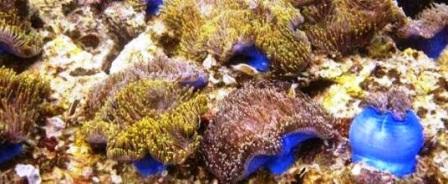Sea Anemones Facts and Species Information
Taxonomy [Actiniaria] [Phylum: Cnidaria] [Class: Anthozoa] [Family: Anthozoa]
Sea anemones' name derives from the resemblance to the eye-catching terrestrial flower - anemone.
They are soft-bodied ornately colored water-dwelling sedentary invertebrate animals (Actiniaria), which attach themselves to rocks at the bottom of shallow coral reefs and deep ocean tidal zones.
Although some sea anemones exist in brackish water, they exist most numerously and grow bigger in temperate warm water environments.
More than 1,000 different species exist in the oceans though the largest majority of sea anemones thrive in the tropics.
The Phylum Cnidarians also includes other tube-dwelling sea anemones and Hydra. The group closely relates to corals and jellyfish.
Sea Anemone Anatomy
Most actinarians and sea anemones display striking anatomical features and vivid colors exhibiting huge varieties in shape, size, and habit.
Some species are a little over 1 cm while larger examples measure almost 2 meters across. The anatomical features of sea anemones structure ranges from thick and stout to long cylindrical and slender.
The mouth-like oral disk is located at the upper of its body and here you will see the anemone's petal-like tentacles.
Anemone tentacles surround the body often in multiples of six. Their colors are commonly bright and striking, often blue or yellow.
 The cylindrical body secures itself to rocks or similar hard surfaces such as coral, seashells or wharf timber.
The cylindrical body secures itself to rocks or similar hard surfaces such as coral, seashells or wharf timber.
Anemones use their adhesive disc-shaped foot or 'pedal disk' to secure themselves but seldom move around the ocean floor.
An array of potent tentacles surrounds its centralized mouth. The tentacles are responsible for killing and maneuvering its prey inside.
Sea anemones use large stinging polyps and venomous tentacles to ensnare passing fish. These elongated sensitive organs fire a paralyzing toxin via harpoon-like filaments. The fish is stunned defenseless and awaits digestion.
The sea anemone forms a symbiotic harmony with its cousin the clownfish. This alliance benefits both members.
The fish's immunity from anemone venom assists its protection from predators and the anemone enjoys snacking on the clown fish’s food scraps and waste products.
Marine Invertebrates |> Overview |> Sea Sponge |> Sea Fans |> Sea Squirts |> Mollusks |> Crustaceans |